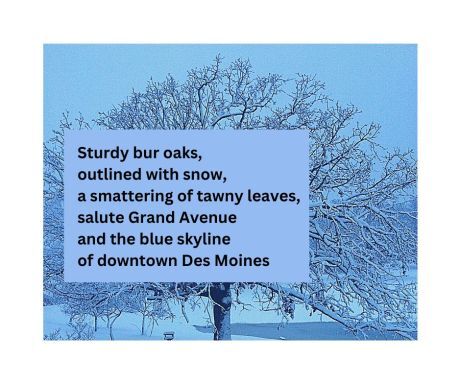Joy Neal Kidney's Blog, page 9
March 6, 2025
Henny Penny and Singing Jenny
 Leora and her flock of chickens, Minburn farm, about 1943
Leora and her flock of chickens, Minburn farm, about 1943When Leora Goff was eleven her mother had yet another baby, so Leora took on the job of caring for the setting hens, ones that brooded their eggs to hatch. She certainly enjoyed her job, as she’d always helped her mother with it before. She knew how to get a reluctant hen to “sit” on her eggs: Pluck up the hen and give her a ride, like a cartwheel in the air, until she is dizzy. She’ll sit.
“One of my jobs on the farm when I was growing up,” she wrote in her memoir, “was teaching calves to drink after taking them from their mothers. Some years there were as many as 20 calves. Another was raising chickens. With setting hens there had to be a coop for each hen and chickens, with about 15 little chicks each, and we always had wooden boxes in those days. We would have to shut each up at night to keep varmints from getting the little chickens and open up their boxes each morning and then feed the chickens. Sometimes we tied the mother by one foot or leg to keep her from roaming too far.”
After she married and had chickens of her own, Leora kept an account of the dates her hens began to brood, laying no more eggs but sitting on their nest, so she knew about when they would hatch, about three weeks later. She also recorded the number of other eggs she gathered in order to sell or trade what they didn’t use. Besides having a source of income, she enjoyed working with a flock of chickens.
A year later Leora stayed busy with nursing a baby, cooking, cleaning, washing and ironing, and tending her chickens. She sold eggs seven dozen at a time early in the year, then twenty-four dozen each time by March 1916. By July, this business woman had sold 350 dozen eggs, then she began selling chickens.
During 1924, Leora sold 135 chickens (earning 14 to 18 cents per pound) and 92 dozen eggs (earning 36-47 cents a dozen). Selling eggs and chickens enabled this mother of six youngsters to order a brand new Singer sewing machine through the Sears, Roebuck catalog.
“I raised a lot of good purebred chickens, Rhode Island Reds, setting hens mostly–had as many as 50 or more hens setting at one time. They had feed and water and were kept in an empty corncrib.”
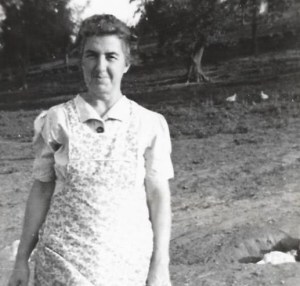 Leora with a bucket of eggs she’d gathered from her flock. One hen is having a dust bath at the lower right. Minburn, Iowa, 1943
Leora with a bucket of eggs she’d gathered from her flock. One hen is having a dust bath at the lower right. Minburn, Iowa, 1943After the Depression years, Clabe and Leora returned to living on a farm near Minburn where Leora kept a flock of chickens. As her sons left for the military, they’d send requests home–someone please take a photo of Dad with a fish or with Spats, let’s have one of Mom and her chickens. A couple of hens followed her around as she did her chores outside. She named them Henny Penny and Singing Jenny.
How about some chicken songs?
March 3, 2025
Harry Potter Powers?
It began as a small itchy crater on my forehead, near an eyebrow. A biopsy showed skin cancer. I was warned that there’d be swelling and that an eye might swell shut.
Last week, Dr. Joshua Wilson performed Mohs surgery on it, carving a round chasm a little smaller than a dime. One of the advantages of Mohs surgery is that you know your results right away. You usually don’t leave your appointment until all of the skin cancer has been removed.
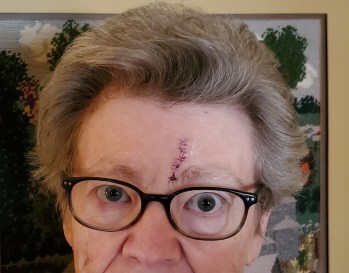 Son Dan suggested that this may give me some powers like Harry Potter and the lightning-shaped scar on his forehead.
Son Dan suggested that this may give me some powers like Harry Potter and the lightning-shaped scar on his forehead.Mohs surgery is considered the most effective technique for treating many basal cell and squamous cell carcinomas, the two most common types of skin cancer. Sometimes called Mohs micrographic surgery, the procedure is usually done in stages, including lab work, while the patient waits. It allows the removal of all cancerous cells for the highest cure rate while sparing healthy tissue and leaving the smallest possible scar. Dr. Wilson removed all three layers the first time.
The surgery was developed by Frederic E. Mohs, MD, in the late 1930s. In the mid 1960s, Perry Robins, MD, studied the procedure with Dr. Mohs took the technique to NYU, where he established the first fellowship training program to teach dermatologists this skin cancer surgery, called Mohs surgery.
Before they discovered how to flash freeze tissue, this took more than one day. After waiting only about 45 minutes for the lab work, Dr. Wilson’s assistant, Taylor, announced that the cancer was gone, then talked about stitches. But how could they stitch the sides of a circle that large? She made a diagram of V-shaped cuts Dr. Wilson would make below and above the crater, borrowing neighboring tissue to suture together. Skin tissue is alive and malleable, and begins to heal itself right away. Just amazing.
The pictures online show how a pretty good sized excision can turn into a nice straight hardly-noticeable scar, but I guess my old author photo will have to do for Meadowlark Songs: A Motherline Legacy.
The whole thing took about three hours, then I kept busy at home icing the area so it wouldn’t swell much, although bruising might show up later. The photo is from two days after surgery, when I was allowed to take off the original bandage. Very little swelling! I’m so grateful.
This skin cancer is probably from detasseling corn, earning my first $100. 1958. The surgery will cost a bit more than how much I earned that entire summer.
An interesting tidbit: Dr. Wilson’s grandmother, age 92, rode on RAGBRAI for years, retiring from it just a few years ago!
February 27, 2025
Grandmother Goff’s Flower Garden Quilt
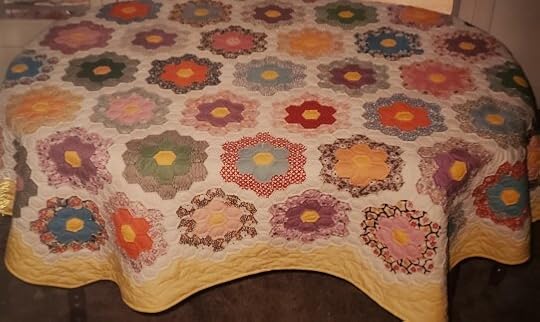 68″ X 84″
68″ X 84″Great Grandmother Laura Goff (1868-1962) had set the blocks together by hand, with no white hexagons around them. It looked very jumbled.
In 1991 I took the blocks apart and washed them. The next year, I cut out white hexagons in and sewed them by hand around each block, completing the top. The hand quilting was done in time to give it to Mom, Doris Wilson Neal (a granddaughter of Laura Goff’s), in time for Christmas that year.
A cheerful treasure!
February 25, 2025
Songs of Heartstrings: Poems of Gratitude and Beatitude
Songs of Heartstrings by Miriam Hurdle
 Songs of Heartstrings: Poems of Gratitude and Beatitude depicts a road traveled with optimism, hope and appreciation amid heartache and unpredictable circumstances. It also celebrates genuine love and fulfilling relationships. The poetry collection includes nine themes: Songs of Nature, Songs of Dissonance, Songs of Physical Healing, Songs of Marriage, Songs of Parenthood, Songs of Tribute, Songs of Reflections, Songs of Challenge, and Songs of Inspiration. Each of these themes covers various aspects of her life experience. The poems are inspiring to the mind, heart, and spirit. The readers will resonate with these experiences. Hurdle illustrates the poems with her photograph and watercolor paintings.
Songs of Heartstrings: Poems of Gratitude and Beatitude depicts a road traveled with optimism, hope and appreciation amid heartache and unpredictable circumstances. It also celebrates genuine love and fulfilling relationships. The poetry collection includes nine themes: Songs of Nature, Songs of Dissonance, Songs of Physical Healing, Songs of Marriage, Songs of Parenthood, Songs of Tribute, Songs of Reflections, Songs of Challenge, and Songs of Inspiration. Each of these themes covers various aspects of her life experience. The poems are inspiring to the mind, heart, and spirit. The readers will resonate with these experiences. Hurdle illustrates the poems with her photograph and watercolor paintings.
My Thoughts
What a beautiful collection of verses and short prose. Divided into themes, the mesmerizing snippets cover the downs and ups of life, from chemo treatments to tributes of loved ones and inspiration. I especially enjoyed those of tribute and inspiration. Her photos add a special grace to Miriam’s blessed words.
About the Author
 Miriam Hurdle is a member of the Society of Children’s Book Writers and Illustrators (SCBWI). She published four children’s books at twenty-six years old. Her poetry collection received the Solo “Medalist Winner” for the New Apple Summer eBook Award and achieved bestseller status on Amazon.
Miriam Hurdle is a member of the Society of Children’s Book Writers and Illustrators (SCBWI). She published four children’s books at twenty-six years old. Her poetry collection received the Solo “Medalist Winner” for the New Apple Summer eBook Award and achieved bestseller status on Amazon.
Miriam writes poetry, short stories, memoir, and children’s books. She earned a Doctor of Education from the University of La Verne in California. After two years of rehabilitation counseling, fifteen years of public-school teaching and ten years in school district administration, she retired and enjoys life with her husband in southern California, and the visits to her daughter, son-in-law, and granddaughters in Oregon. When not writing, she engages in blogging, gardening, photography, and traveling.
Please learn more about Miriam here.
February 21, 2025
Winners of the Our Iowa Lucky I Contests
It was fun to run ads for the Leora books in beautiful issues of Our Iowa magazine. I also participated in their Lucky I contest by offering gift certificates for part of the cost of the ads. Two winners have recently sent the best thank yous!
 Marlo Rold, Margaret Law, Sue Rasmussen, Kathy Sanders at Off the Rails Quilt Shop in Bondurant
Marlo Rold, Margaret Law, Sue Rasmussen, Kathy Sanders at Off the Rails Quilt Shop in BondurantFrom Margaret Law: “In January I was a Lucky I winner of $100 gift card to Off The Rails Quilt Shop in Bondurant IA, donated by Joy Neal Kidney.
“Not being a quilter or a sewer, I knew just how to spend the money. The Ankeny Women’s Club makes comfort pillows to donate to hospitals and cancer centers. Four members shopped and bought material for pillowcases. What a fun day looking at all the material and choosing many prints, especially prints that children might like. Thank you, Our Iowa Magazine for the fun experience of finding the I’s, and especially to Joy for the certificate.”
Margaret said they made a day of it, including having lunch out.
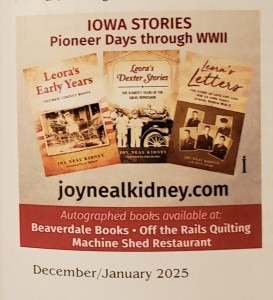 One of my ads had a Lucky I tucked into it! There are three to discover in each issue.
One of my ads had a Lucky I tucked into it! There are three to discover in each issue.Another thank you came from Cathy Nelson, who won the Machine Shed Restaurant gift card. She wrote,” I wanted to take a moment to tell you thanks for the gift card to the Machine Shed. What a great place to eat! I was very excited to see my name in Our Iowa Magazine. My father-in-law is 92 years old, and one of his favorite things to do is read the Our Iowa Magazine and find out what the newest contests are. H always calls to let me know ‘We have a contest,’ and I help him send in our postcards. He always says, ‘Cathy, if I wen I will share whatever I win,’ so I will make sure I share your generous donation with him. He was so excited to see we had won. . . . please know you made a 92 year old man’s day.”
Our Iowa is such a delightful magazine, fun stories and such glossy photos. Stacy Siegner in their advertising department was also wonderful to work with.
February 18, 2025
We Don’t Want Any Heroes in the Family
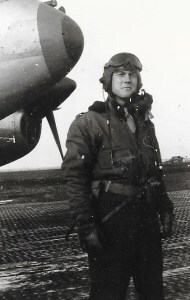
A fighter pilot, Danny Wilson was lost
in February 1945, when his silver Lightning
dropped back to take photos
on a mission over Austria.
Danny's last furlough home to Dallas County, Iowa,
was the spring of 1944. His picture, taken in Perry,
shows his solid jaw, broad shoulders.
Confidence, contentment.
Silver pilot's wings against the dark uniform.
In a snowy forest in the foothills of the Alps,
Wehrmacht personnel find a dead "American
flying lieutenant" in the wreckage of
his "forktailed devil."
The Wilsons had also taken snapshots of Danny
beside the '42 Plymouth with his sisters
and holding his nephew. Doris, her first baby due
in six weeks, stood behind Darlene and Danny
so her "condition" wouldn't show.

The airman who lost his life at Schwanberg, Austria,
in February of 1945, was identified by his dogtags,
which the Wehrmacht kept--Daniel S. Wilson.
When Danny began cadet training, Doris wrote,
"I just want you to know, whether you turn out
to be an ace or a grease monkey,
you'll still be a swell brother to me."
The 37th Fighter Squadron in Italy reported his P-38 lost,
his belongings were inventoried, and the flight surgeon added
to an official form, "good man--good pilot."
When he got his overseas orders, Doris wrote,
"Danny, you take darn good care of you,
and get home as soon as possible.
We don't want any heroes in the family,
just all of us home."
At Danny Wilson's first burial were four strangers:
the village inspector, the bergermeister,
the grave digger, and the Roman Catholic priest,
who held a burial ceremony for him--secretly.
His parents received a telegram in March 1943
with the news that he was MIA. But they never learned
the details of his death and burial. The daughter
born to Doris was the first family member to see,
fifty years later, his casualty records.
That fall, after the war was over,
Danny's grave was located
by a British Graves Registration Team,
through captured Germany records.
But Danny Wilson's parents received no more word
until January 1946, when the War Department reported
that it had received "evidence sufficient
to establish the fact of [his] death."
In a carton sent home with his other belongings,
was a small New Testament.
On the page with the American flag, Danny had written,
"I give everything for the country it stands for."
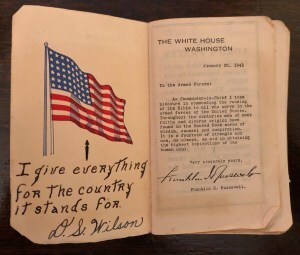
All five Wilson brothers served in the war--
two in the Navy, three in the Army Air Corps.
At age 21, Danny was one of the three young pilots
who never came home.
February 4, 2025
Spats, the Wilson Family’s Favorite Pet
 Bottom to top: Spats, Junior, Danny, Dale Wilson, Dexter, 1936When the next door neighbor’s Boston terrier had a single puppy, he brought it over to show the Wilsons, who lived at Dexter at the time. Doris and Dale were home and fell in love with it right away.
Bottom to top: Spats, Junior, Danny, Dale Wilson, Dexter, 1936When the next door neighbor’s Boston terrier had a single puppy, he brought it over to show the Wilsons, who lived at Dexter at the time. Doris and Dale were home and fell in love with it right away.“It’s not a purebred so we’re going to sell it,” Joe said. “You wouldn’t want to buy it, would you?”
“How much?”
“Two dollars.”
“Two dollars! Let’s ask Mom.”
“Well, he sure is a cute pup,” she said, “but you’ll have to ask your dad.”
Clabe said no. It would cost too much to feed it.
Doris began to cry. So did Dale.
“Okay, okay. I can’t stand for big kids to cry.” Clabe suggested a deal. “If you can get the dog for a dollar, you can have it.”
The neighbor accepted the dollar, and the Wilsons had a new family pet. They made a bed for him on the back porch, where he always greeted his family. Danny was in junior high that fall and got home from school first. The pup was so glad to see him that he leaped right into his arms.
One day Mrs. Wilt was visiting with Leora when Danny reached home. They watched him hug the dog and even give it a kiss. Mrs. Wilt glanced at Leora. “Isn’t that sweet?”
Darlene wrote her brothers in the Navy (Delbert and Donald) all about school, and about the cutest puppy “a foot long and as round as a barrel. We can’t get a name to suit him. If you have any suggestions, let’s have them. He’s kind of a light brindle with a white spot on his head, two front white paws, and the black paws just have the tips of white.”
Delbert came up with the name “Spats.” He and Donald had played in their uncles’ uniforms from the world war, which included spats that covered a soldier’s insteps and ankles.
According to ten-year-old Junior, “Spats is the best dog in the country–he’s the smartest dog, too.”
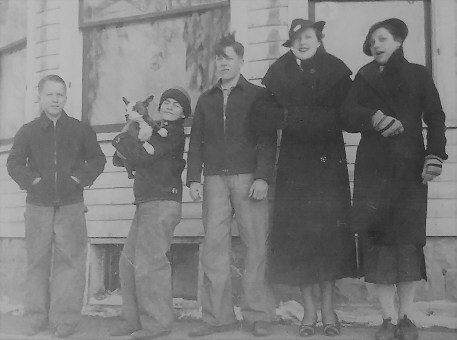 Danny, Junior with Spats, Dale, Doris, Darlene Wilson, Christmas 1935, Dexter, Iowa
Danny, Junior with Spats, Dale, Doris, Darlene Wilson, Christmas 1935, Dexter, IowaSpats liked to go along with Clabe and his sons when they went hunting. When the family moved to the Minburn farm with the family in 1939, their pet moved as well. When they carried Fig Newtons to snack on, they discovered that Spats liked them as well, so they always had some along.
 Spats with Lt. Dale Wilson, on his last furlough home. February 16, 1943, Minburn, Iowa
Spats with Lt. Dale Wilson, on his last furlough home. February 16, 1943, Minburn, IowaIn their letters home from military service, the Wilson brothers often asked how Spats was.
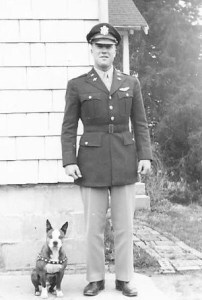 Spats with Lt. Dan Wilson, on his last furlough home, April 26, 1944, Minburn, Iowa.
Spats with Lt. Dan Wilson, on his last furlough home, April 26, 1944, Minburn, Iowa.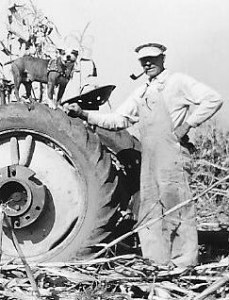 Spats enjoyed riding in the landlord’s truck, and being with Clabe in the field. Spats and Clabe, 1940s, Minburn farm
Spats enjoyed riding in the landlord’s truck, and being with Clabe in the field. Spats and Clabe, 1940s, Minburn farmAfter all their sons were serving in WWII, Clabe and Leora bought an acreage near Perry. After Junior was killed, oldest brother Delbert and his family moved home to be with his grieving parents. The Clabe died in late 1946.
Leora spent part of 1947 with her mother in Omaha. The very last mention of Spats was in a note from Delbert’s wife Evelyn to Leora in December 1947. “Spats has gone.”
We’ll never know what happened to the family’s favorite pet.
February 1, 2025
Soul Mates: Path to a Praying Partnership by Nick & Mary Portzen
Soul Mates: Path to a Praying Partnership
 Back cover: Are you satisfied with a good (or good enough) marital relationship, or would you like an extraordinary one? With over seventy years of marriage between them when they met, the authors soon discovered how little they knew about a partnership centered on God. Praying together since their second date, they discovered the intimate spiritual discipline of prayer as a powerful relationship tool.
Back cover: Are you satisfied with a good (or good enough) marital relationship, or would you like an extraordinary one? With over seventy years of marriage between them when they met, the authors soon discovered how little they knew about a partnership centered on God. Praying together since their second date, they discovered the intimate spiritual discipline of prayer as a powerful relationship tool.
With a unique framework that includes both wife and husband’s perspective, this book shares lessons they learned and includes questions to facilitate discussion. Whether reading separately or together, couples can use this book to unlock a practice that will enrich and fortify their marriage.
My Thoughts
Mary and Nick had both lost their spouses when Mary was prompted to pray for a future husband. Three years later she met Nick, who was open to seeking God’s will even while they dated. It was a delight to learn they’d married, then later they were writing a book about what a God centered marriage can be. Both Nick and Mary are transparent about their attitudes and stumbles, but also how praying together helped them to better understand the other, and those around them as well. This is their love story but also an encouragement, with discussion questions in each chapter, prayer suggestions, and room to write your own. A wonderful resource no matter your age. Soul Mates.
The Authors
Nick and Mary Portzen are co-coordinators of the annual Cedar Falls Christian Writers Conference in Cedar Falls, Iowa, where they live. Nick is a former business owner. Mary is a certified grief counselor and workshop presenter. She is the author of seven books under the name Mary Potter Kenyon, including the award-winning Refined by Fire: A Journey of Grief and Grace and Called to Be Creative: A Guide to Reigniting Your Creativity. Nick and Mary speak on the topic of couples praying together.
January 28, 2025
The Shadows in Our Home
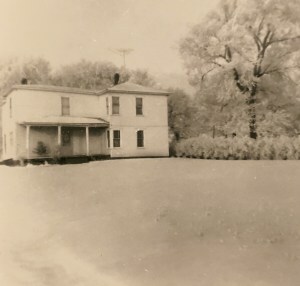
The Shadows in Our Home
were cast by my mother’s younger brothers–
Dale, Danny, and Junior. I was aware that all three
had lost their lives during the war. Mom didn’t talk about
those stories, but she did talk about when they were kids
during the Great Depression. Their pictures in uniform,
along with her two older brothers in uniform and with
their wives sat on bookshelves sometimes. Sometimes
Mom put them away, when the shadows began
to overwhelm her again, attempting to drag her
into a dark place. They weren’t in sight but
their shadows still lingered.
This is in one of the chapters of Meadowlark Songs: A Motherline Legacy, due out later this year.
January 25, 2025
That Bur Oak Tree
 His is in a more picturesque setting, but this one is in the parking lot of our favorite chiropractor, taken last fall.
His is in a more picturesque setting, but this one is in the parking lot of our favorite chiropractor, taken last fall.I’m grateful to Erin Moroney LaBelle for introducing this photographer. I’m a fan of bur oaks, so it’s a double delight for me that a treasured one became Mark Hirsch’s focus. They both have such a following!
“A lone bur oak may have forever changed the professional and personal life of one photographer in northeastern Iowa. In 2012, Mark Hirsch began a 365-day photographic journey with a single picture on his iPhone.”
CBS News (3 minutes)
Iowa PBS (10 minutes)
